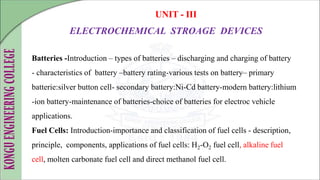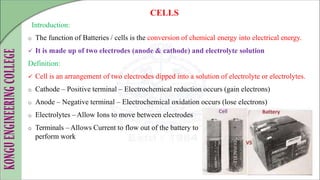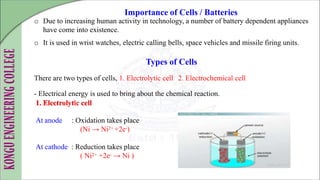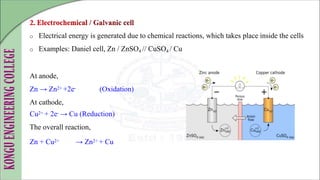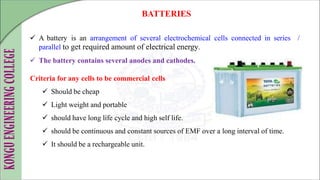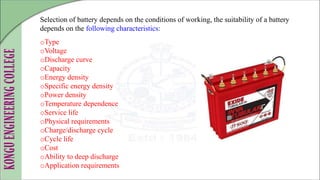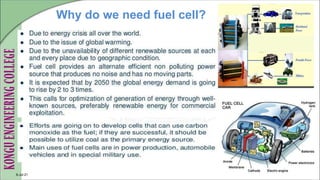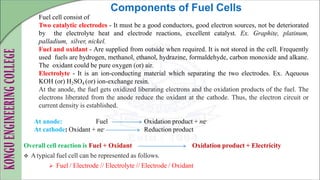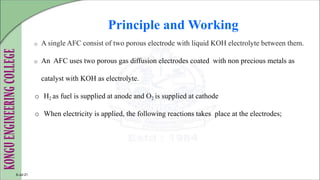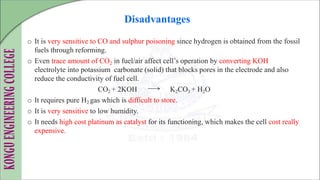Electrochemical Stroage Devices_Alkaline Fuel Cell.ppt
- 1. DEPARTMENT OF CHEMISTRY WELCOMESYOUALL 22CYT12 & Chemistry for Computer Systems (Description, Principle, Components and Applications of Alkaline Fuel Cell ) Prepared By Krishnaveni K Assistant Professor Department of Chemistry Kongu Engineering College, Perundurai, Erode-638060
- 2. UNIT - III ELECTROCHEMICAL STROAGE DEVICES Batteries -Introduction – types of batteries – discharging and charging of battery - characteristics of battery –battery rating-various tests on battery– primary batterie:silver button cell- secondary battery:Ni-Cd battery-modern battery:lithium -ion battery-maintenance of batteries-choice of batteries for electroc vehicle applications. Fuel Cells: Introduction-importance and classification of fuel cells - description, principle, components, applications of fuel cells: H2-O2 fuel cell, alkaline fuel cell, molten carbonate fuel cell and direct methanol fuel cell.
- 3. Introduction: o The function of Batteries / cells is the conversion of chemical energy into electrical energy. It is made up of two electrodes (anode & cathode) and electrolyte solution Definition: Cell is an arrangement of two electrodes dipped into a solution of electrolyte or electrolytes. o Cathode – Positive terminal – Electrochemical reduction occurs (gain electrons) o Anode – Negative terminal – Electrochemical oxidation occurs (lose electrons) o Electrolytes –Allow Ions to move between electrodes o Terminals –Allows Current to flow out of the battery to perform work CELLS
- 4. Importance of Cells / Batteries o Due to increasing human activity in technology, a number of battery dependent appliances have come into existence. o It is used in wrist watches, electric calling bells, space vehicles and missile firing units. Types of Cells There are two types of cells, 1. Electrolytic cell 2. Electrochemical cell - Electrical energy is used to bring about the chemical reaction. At anode : Oxidation takes place (Ni → Ni2+ +2e-) At cathode : Reduction takes place ( Ni2+ +2e- → Ni )
- 5. o Electrical energy is generated due to chemical reactions, which takes place inside the cells o Examples: Daniel cell, Zn / ZnSO4 // CuSO4 / Cu At anode, Zn → Zn2+ +2e- (Oxidation) At cathode, Cu2+ + 2e- → Cu (Reduction) The overall reaction, Zn + Cu2+ → Zn2+ + Cu
- 6. BATTERIES A battery is an arrangement of several electrochemical cells connected in series / parallel to get required amount of electrical energy. The battery contains several anodes and cathodes. Criteria for any cells to be commercial cells Should be cheap Light weight and portable should have long life cycle and high self life. should be continuous and constant sources of EMF over a long interval of time. It should be a rechargeable unit.
- 7. Selection of battery depends on the conditions of working, the suitability of a battery depends on the following characteristics: oType oVoltage oDischarge curve oCapacity oEnergy density oSpecific energy density oPower density oTemperature dependence oService life oPhysical requirements oCharge/discharge cycle oCycle life oCost oAbility to deep discharge oApplication requirements
- 8. 9-Jul-21 Why do we need fuel cell?
- 9. •Hence based on the electrolyte used fuel •cells are classified as follows Alkaline Fuel cells Methanol –Oxygen Fuel cell Phosphoric Acid Fuel Cells(PAFCs) Molten Carbonate Fuel Cells(MCFCs) Solid Oxide Fuel Cells(SOFC) Solid Polymer Electrolyte Fuel Cells(SPEFCS) Microbial Fuel cells(MFCs) 9-Jul-21 Classification of fuel cell is very difficult as several operational variable exists Classification of Fuel Cells
- 10. FUELCELLS o The basic principle of a fuel cell is the same as that of electrochemical cells. o Single fuel cell generates only little DC and hence many fuel cells are assembled into a stack. o It has a separate fuel-oxidant system that produces electrochemical reaction in which the fuel is oxidized at the anode. o Like other electrochemical cell, the fuel cells also consist of two electrodes and electrolyte. o The main difference in the cell function is that electrochemical energy is provided by a fuel and an oxidant which is stored out side the cell, however, in batteries, all theses things will be packed in single container. o Hence, fuel cells can produce endless electrical power unless they are supplied with fuels and oxidants. 9-Jul-21
- 11. Fuel cell consist of Two catalytic electrodes - It must be a good conductors, good electron sources, not be deteriorated by the electrolyte heat and electrode reactions, excellent catalyst. Ex. Graphite, platinum, palladium, silver, nickel. Fuel and oxidant - Are supplied from outside when required. It is not stored in the cell. Frequently used fuels are hydrogen, methanol, ethanol, hydrazine, formaldehyde, carbon monoxide and alkane. The oxidant could be pure oxygen (or) air. Electrolyte - It is an ion-conducting material which separating the two electrodes. Ex. Aqeuous KOH (or) H2SO4 (or) ion-exchange resin. At the anode, the fuel gets oxidized liberating electrons and the oxidation products of the fuel. The electrons liberated from the anode reduce the oxidant at the cathode. Thus, the electron circuit or current density is established. At anode: Fuel At cathode: Oxidant + ne- Oxidation product + ne- Reduction product Overall cell reaction is Fuel + Oxidant Oxidation product + Electricity Atypical fuel cell can be represented as follows. Fuel / Electrode // Electrolyte // Electrode / Oxidant Components of Fuel Cells
- 12. Alkaline Fuel Cells o In alkaline fuel cells, the electrolyte used is an alkali, such as potassium hydroxide (30–40% aqueous solution). o The alkaline fuel cells make use of high purity hydrogen as fuel and oxygen as oxidant. This kind of fuel cell is otherwise known as hydrogen – oxygen fuel cell. o These are low temperature (70°C) fuel cells o This type of fuel cell is being developed for transport applications as well as for stationary fuel cell applications and portable fuel cell applications. o AFC’s are also called Bacon fuel cells after their British inventor Francis Thomas Bacon. 9-Jul-21
- 13. Components of Alkaline Fuel Cell •Anode : Porous carbon containing Ni/Pt catalyst •Cathode : Porous carbon containing Ni/Pt catalyst •Electrolyte : Aqueous KOH •Fuel : Pure Hydrogen •Oxidant : Pure Oxygen •Electrical Efficiency : 60-70% •Temperature : 70°C •Single fuel cell voltage : 0.5-0.9V AFC consumes pure H2 and O2 to produce portable water, heat and electricity.
- 14. Principle and Working o A single AFC consist of two porous electrode with liquid KOH electrolyte between them. o An AFC uses two porous gas diffusion electrodes coated with non precious metals as catalyst with KOH as electrolyte. o H2 as fuel is supplied at anode and O2 is supplied at cathode o When electricity is applied, the following reactions takes place at the electrodes; 9-Jul-21
- 15. At anode: H2 (g) 2H+ + 2e- 2H+ + 2OH- (aq) 2H2O (l) H2 (g) + 2OH- (aq) 2H2O (l) + 2e- At cathode: 1/2O2 (g) + H2O(l) + 2e- 2OH- Over all reaction: H2 (g) + 1/2O2 (g) H2O (l) + E + Heat o At anode: H2 oxidizes to H+ ions which react with OH- ions of electrolyte to form H2O. o The negatively charged e- cannot flow through electrolyte and hence they must flow through external circuit forming electric current. o O2 enter the fuel cell at cathode and picks up the e- and then travel through the electrolyte towards the anode and combines with H+ to form water.
- 16. Applications • AFC’s are limited to closed environments, such as space, undersea vehicles and must run on pure H2 and O2. • Along with Phosphoric acid fuel cells, they were one of the earliest fuel cells developed and used by NASA. • The first alkaline fuel cells were used by NASA in the Apollo missions to provide power as well as provide with potable water for the astronauts. • The alkaline fuel cell is commercially incubated into a 22 seated hydrogen ship, power associated by an electric motor gets its electricity from a fuel cell. • The ship is known as HYDRA, it was used as a ferry boat in GHENT, Belgium. 9-Jul-21
- 17. Advantages It is simple, lighter and compact due to their thin sheet of polymer electrolyte. It operates at low temperature. Their reaction starts quickly. It operates at any orientation. It just emits water vapour and no other harmful chemicals to the environment. The efficiency is higher than about 75 %. It can replaces the use of batteries and causes less noise pollution. Low maintenance cost
- 18. Disadvantages o It is very sensitive to CO and sulphur poisoning since hydrogen is obtained from the fossil fuels through reforming. o Even trace amount of CO2 in fuel/air affect cell’s operation by converting KOH electrolyte into potassium carbonate (solid) that blocks pores in the electrode and also reduce the conductivity of fuel cell. CO2 + 2KOH K2CO3 + H2O o It requires pure H2 gas which is difficult to store. o It is very sensitive to low humidity. o It needs high cost platinum as catalyst for its functioning, which makes the cell cost really expensive.

